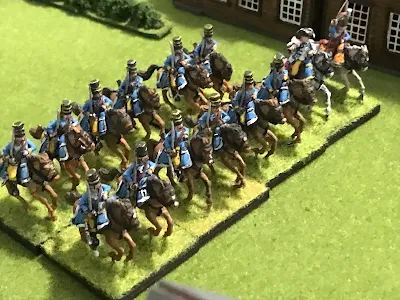Here we go with the first of three table top battles based on the river crossing scenario devised by Norm on his blog "Battlefields and Warriors. " For details of the game please reference back to the previous post.
Set in 1776 an American and British force are attempting to capture a major bridge crossing. Because of its importance the bridge cannot be destroyed but must be captured intact. Both sides have similar sized forces which reflects the armies of their time period. Victory conditions are to capture and hold both sides of the bridge by game end. If either force is reduced to under 50% that side must retreat off the board and has lost. In addition both sides may select one unit to out flank the enemy and appear on a random turn on the enemies flank across the river. I rolled to see which side of the table to set up on. I also came up with two battle plans for each side for what they wanted to do.
The American force consists of three Continental line regiments (13th, 14th and 26th Continental regiments), two militia regiments, a rifle regiment, a Light Dragoon regiment (3rd Continental) and a medium artillery battery (Hamilton's NY). There plan was to rush the militia and rifles up to the river and lay down a deadly fire to try and cause as many casualties as possible. The artillery will cover the bridge in case the British try and cross. Two Continental regiments will act as reserve by the bridge while the third will cover the left flank in case of enemy attacks. Because the river bend covers their right flank they do not have to worry about that flank. The Light Dragoons are sent on a out flanking mission to cause mischief behind British lines.
The Crown forces set up to try and rush the bridge. Two Hessian regiments (Bose and Lossberg) will deploy to the left of the river while two British regiments (10th & 49th) deploy to the right of it. They will support any attack across the bridge. The Royal Artillery will set up on the hill. All of this is to cause casualties to the Americans. The British Legion Dragoons will charge across the bridge. The Grenadier battalion will support them. Regiment Rall will attempt to out flank the enemy.
Now, let the game begin!
On the first turn both sides set up four inches from their base line. Both sides moved forward with the Americans throwing their rifle (operating in two wings) and militia units forward and the Continental line in reserve. The British sent the Legion Dragoons across the bridge hopping to surprise the enemy.
On the second turn the Legion Dragoons crossed the bridge, formed line and smacked into the left wing of the rifle unit. While the British brought their regiments up towards the river and deployed the artillery on the hill, the Americans prepared to give the Legion Dragoons a warm welcome.
The bold plan with the Legion Dragoons didn't work out so well. The Rifle's morale held, they and the surrounding units got to fire and the Legion retired shaken. ( note: I allowed the Dragoons to retire up to the river bank. I suppose they should be eliminated because they couldn't cross but I made a arbitrary decision). Meanwhile the Grenadier battalion has crossed the bridge on deployed into line.
On turn 3 exciting things happened. The Americans roll less then the turn number so their off board regiment, the 3rd Continental Light Dragoons charged in from the British left flank. They plowed right into the Lossberg regiment who did not have time to face about. The poor Hessians routed and It. Col. Washington turned his cavalry about to threaten the Royal Artillery on the hill.
But across the river the Grenadiers and Legion Dragoons charged the two wings of the rifle regiment and easily destroyed them. The Grenadiers took position on the militia's left flank while the Dragoons charged the 14th Continental regiment. The 14th failed morale shaken and fell back!
Obviously the American plan to defend the bridge was going to pot. The British were now in a position to threaten the American defence and reinforcements are marching across the bridge. What else could go wrong?
Well, plenty. On turn four the British rolled for their off board Regiment to enter. On the American left flank marched Colonel Rall and his regiment of (land) Grenadiers! They quickly routed the militia in front of the and faced to challenge the nearest Continental line regiment.
The Legion Dragoons continued the ride against the 14th who had rallied. This time the Continental stood their ground and in a example of good shooting decimated the Dragoons and shot Colonel Tarleton off his horse!
The British Grenadiers charged the 13th Continentals Regiment and drove the back. The militia witnessed this and failed their morale check and bolted!
Meanwhile across the river Lt.Col.Washington charged the Royal Artillery who stood to their guns and fired a round of grape shot. Both sides suffered casualties but the Dragoons were forces to retire shaken.
At this point I called the game. My poor Americans had bad dice rolls and everything that could go wrong went wrong. That said it was a entertaining game and a good senario. The random reinforcements arriving on an enemies flank makes things most interesting. Although there was a roll to slightly change your army (taking away A regiment or upgrading one) that did not happen in thus game. All in all I enjoyed it very much, and since Tarleton was killed at least the Americans could write home about something positive!




















.jpeg)








